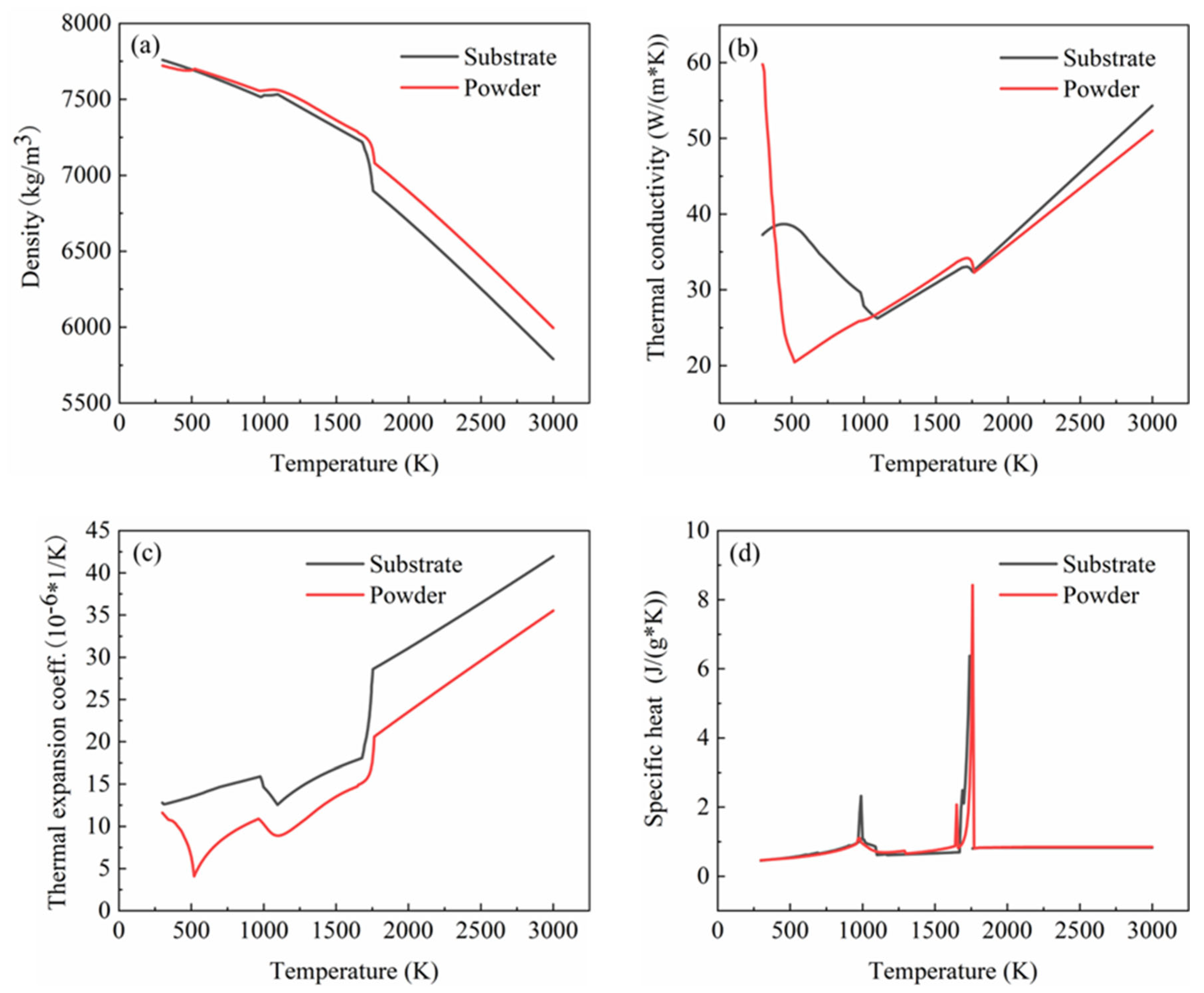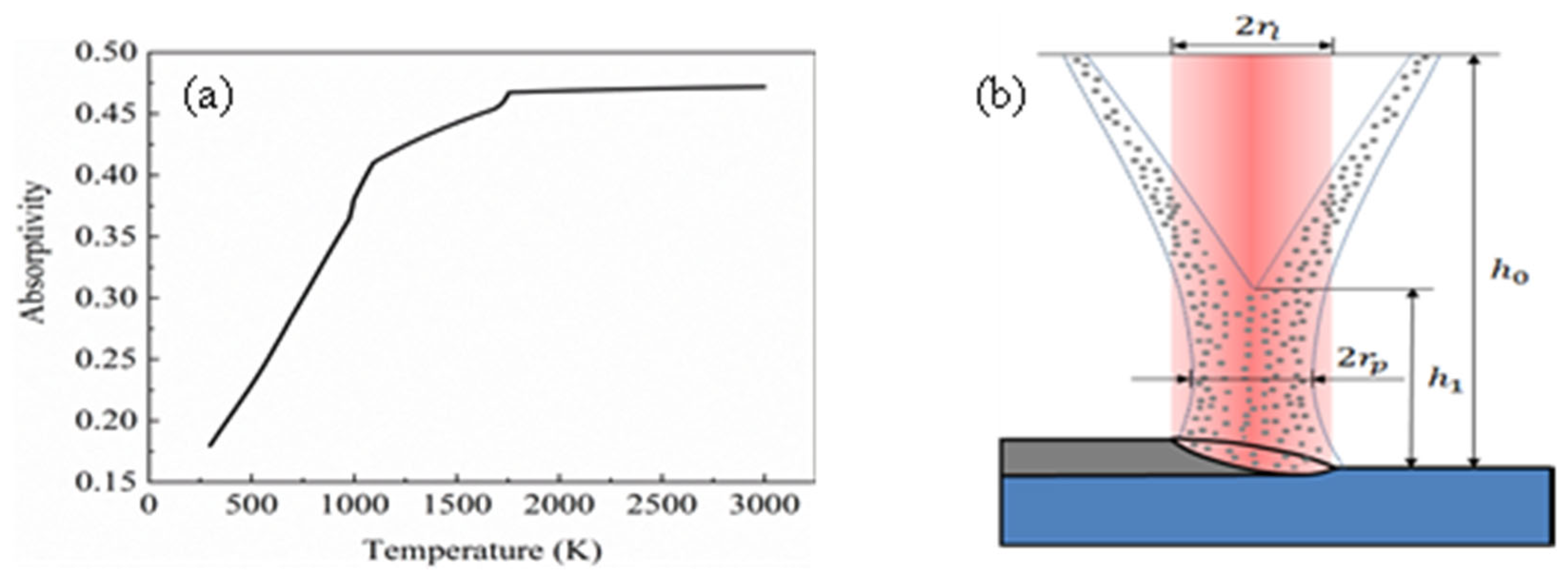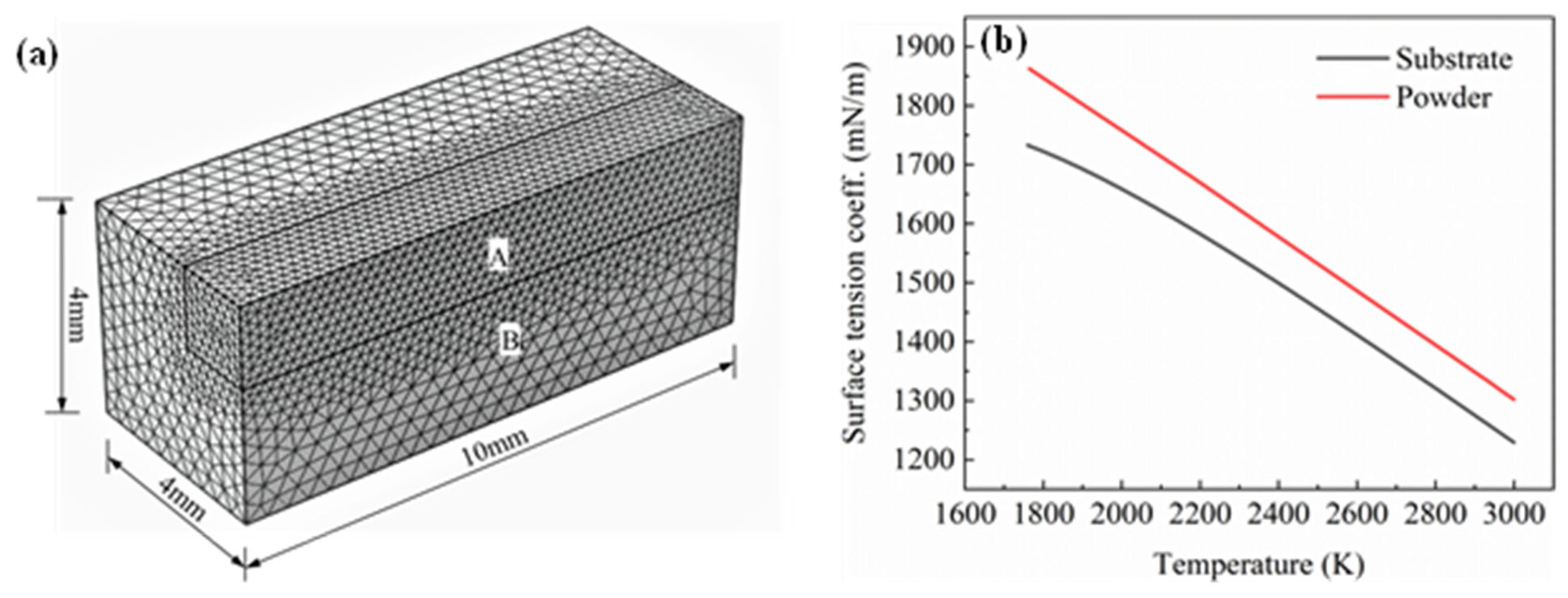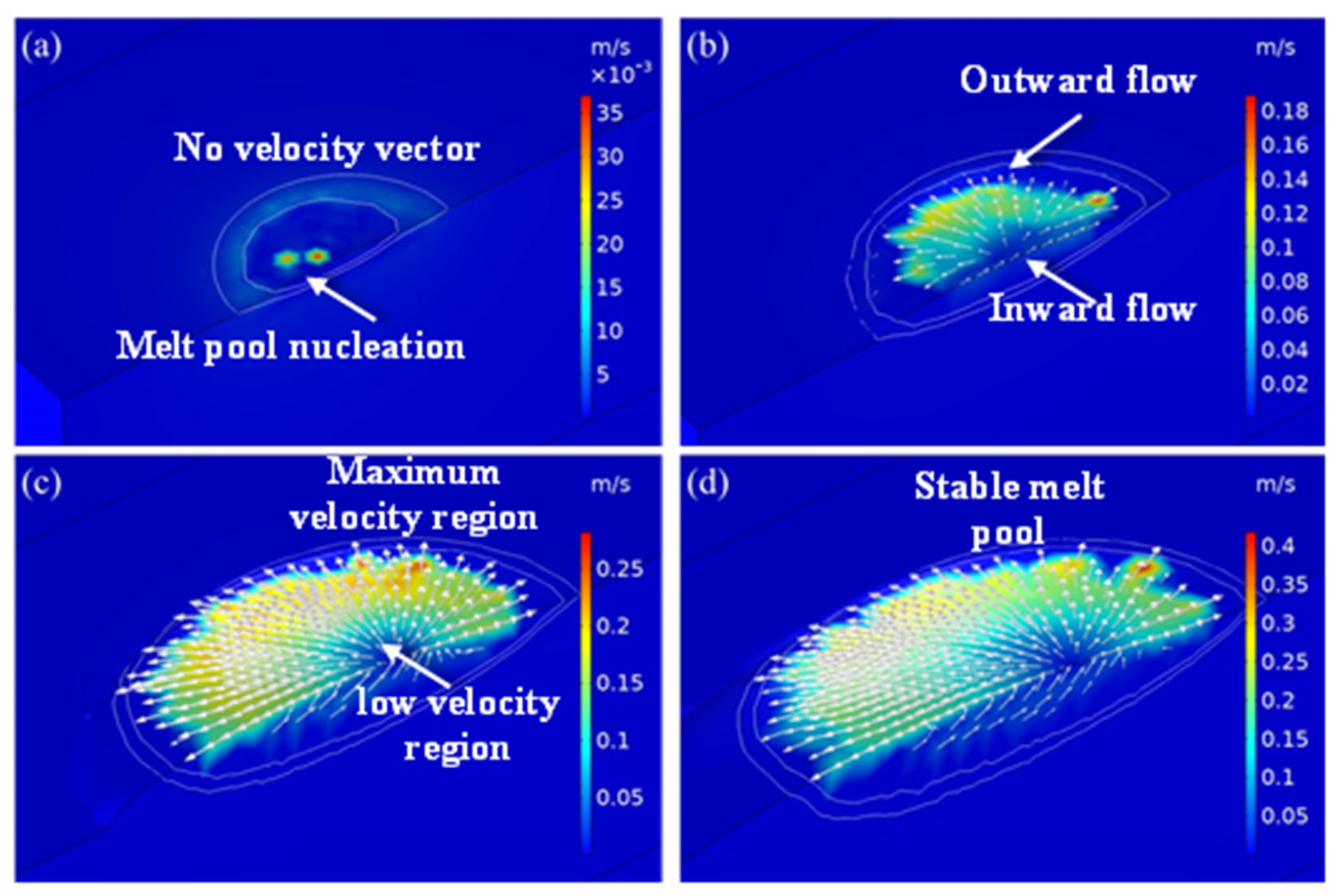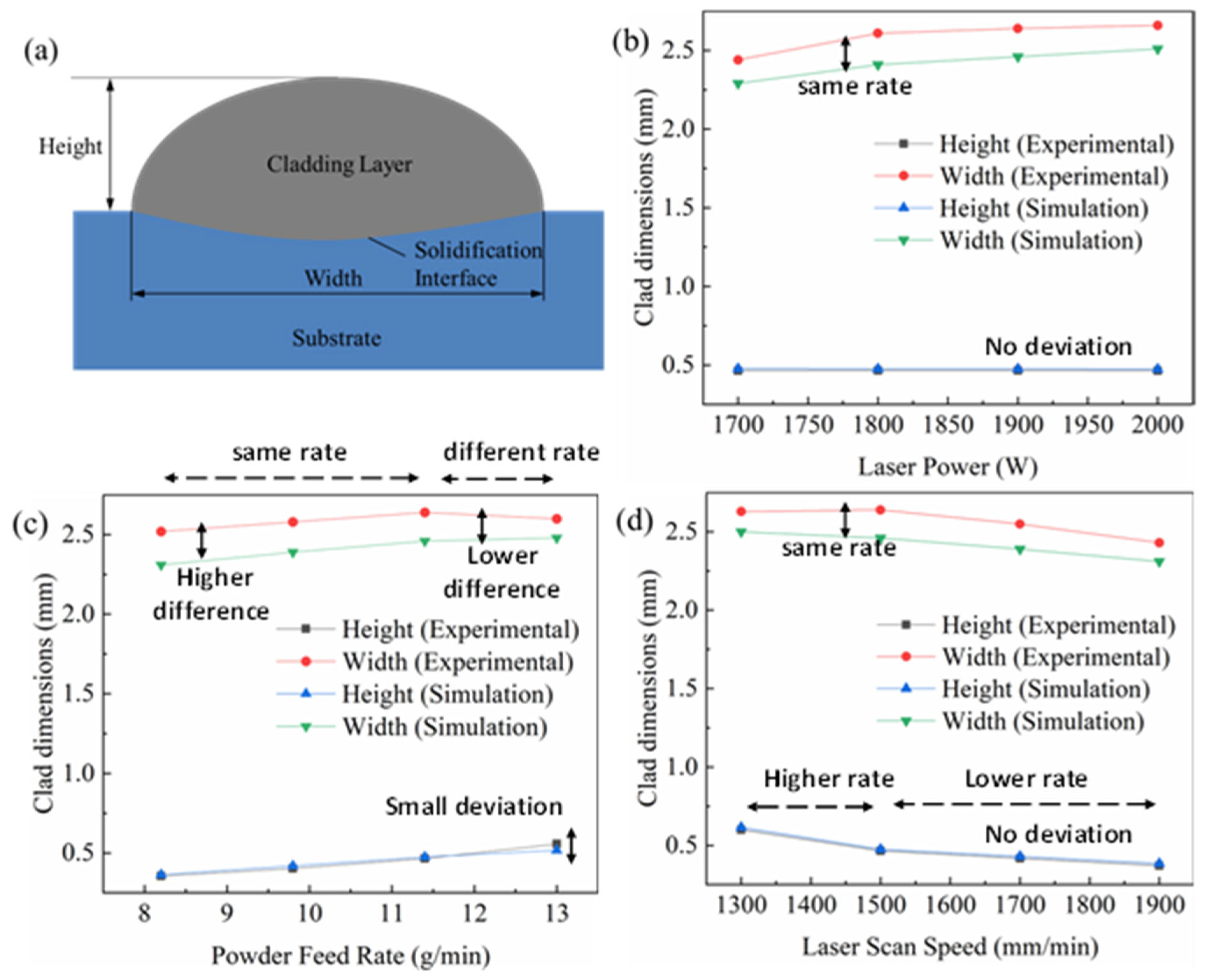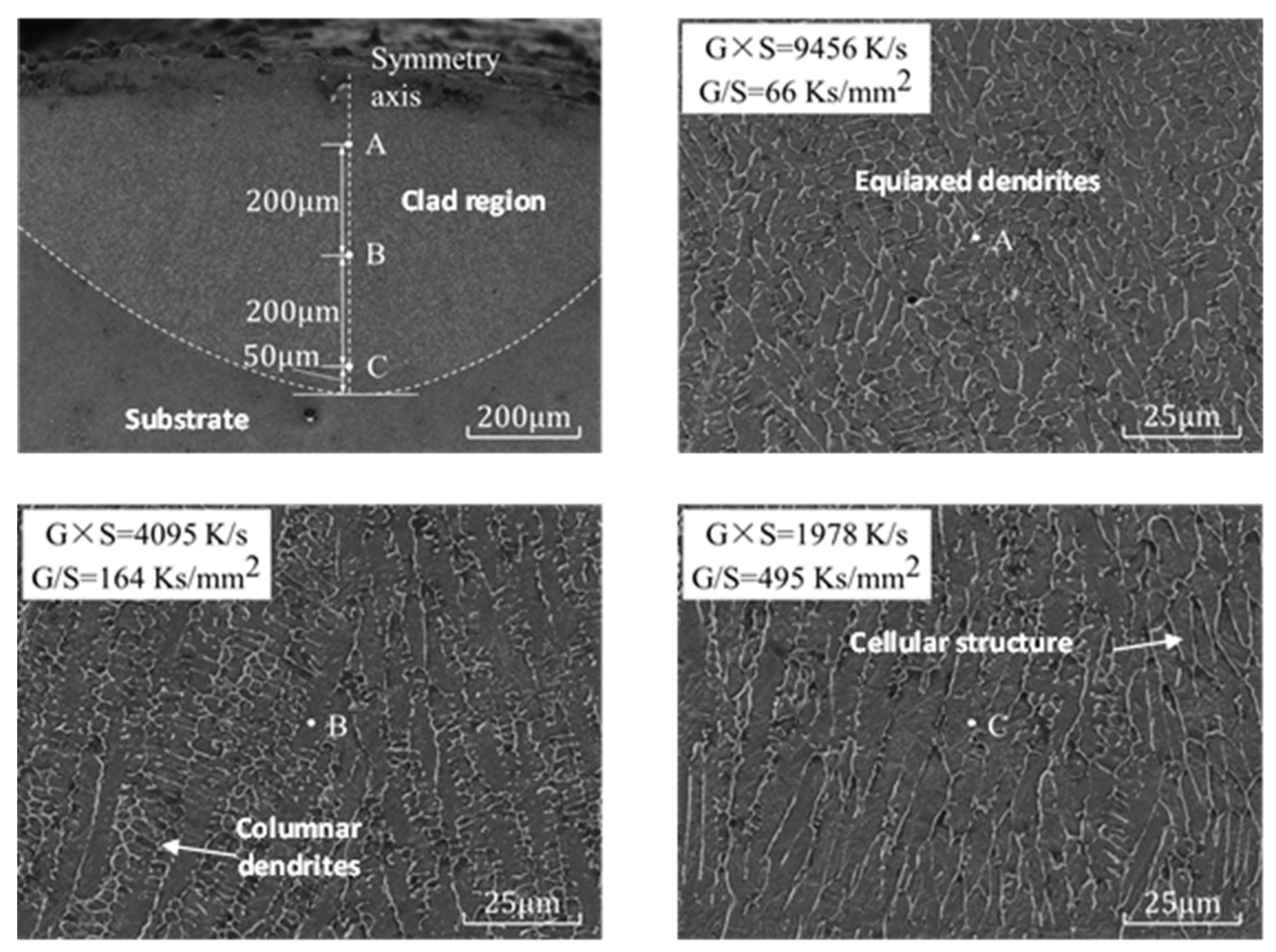3.1. The Results of Numerical Calculation
A heat source was applied on the upper surface of the model. The initial conditions and boundary conditions are given in
Section 2.2.3 and
Section 2.3, and the temperature at different times was obtained. The simulated temperature distribution profile at different time intervals of the laser beam interaction with the substrate surface is shown in
Figure 5. Two semi-circle dotted curves represent the solid and liquid phase separation. The outside curve shows the solid phase limit, whereas the inside curve denotes the liquid phase limit. The direction of the arrow shows that the energy was transferred from the centre to the outside. The length of the arrow reveals the energy level at that particular point. The direction of the arrow is around the hemispherical curve, as the transfer of energy has taken place in a direction perpendicular to an isothermal vector. The sum of (1) the energy absorbed by the powder and the substrate and (2) that reflected by the powder and substrate are equivalent to the total energy involved during the laser cladding process. The sudden increases in the temperature of the 27SiMn substrate (red colour in
Figure 5) revealed that the substrate has the capability of a high absorption rate. The semi-circular shape uniformly increased and then diverged in shape within the four stages. These stages took place from the start of the interaction of the laser beam to the movement of the laser beam to the next stage. These variations occurred due to the supply of thermal energy as well as heat transfer from the melt pool to the atmosphere. A detailed discussion of each stage is carried out below.
The interaction of the laser beam with the cladding region within the duration of 20 ms is shown in
Figure 5a. In this initial stage of laser cladding, the laser started heating the substrate; the melt pool was not formed at this time, and the temperature was reduced from the centre to the surrounding area. One of the assumptions made was the isotopic property that resulted in the circular shape of the temperature distribution at this initial stage. The arrow length was very small, which confirmed the lower energy level during the initial stage compared to the remaining stages. The temperature of the cladding region rose to 1600 K (yellow colour) at the time of 30 ms from the laser beam interaction with the substrate. However, the size of the circle was very small, and the isotherm coverage area was less. This shape deviated continuously as the time of interaction increased.
The isotherm distribution of the first 50 ms duration of the laser beam interaction with the cladding region is shown in
Figure 5b. In this laser cladding stage, the significant size of the melt pool was observed, and the temperature reached up to 2200 K (light red colour). However, the size of the highest temperature distribution was very much less, but higher than that of the temperature stage at 30 ms. The temperature loss to the surrounding atmosphere was low, which was confirmed by maintaining the isotherm as an approximate semi-circle and not stretching more. Small deviations in the semi-circle shape confirmed the interaction with the surrounding atmosphere medium. The arrow length was larger compared with that of the 30 ms of the isotherm profile due to an increase in the energy level. The isotherm size was larger than that of the 30 ms profile, which revealed the increase in the coverage region and melting of a large amount that led to the forming of the cladding region accordingly.
The interaction of the laser beam with the cladding region within the duration of 100 ms is shown in
Figure 5c. The local temperature was higher than the material liquid phase line temperature, which increased the size of the melt pool. In this laser cladding third stage, the deviation of the semi-circle was observed as the heat energy lost to the surrounding atmosphere space. The maximum temperature of 2400 K (dark red colour) was reached at the centre of the melt pool region. The arrow length was larger, which confirmed the large energy level compared to the remaining stages. However, the size of the circle was large, and the isotherm coverage area was large. This shape deviated continuously as the time of interaction increased. As the powder continued to accumulate in the melt pool, the cladded surface began to deform.
The isotherm distribution of the first 150 ms duration of the laser beam interaction with the cladding region is shown in
Figure 5d. In this laser cladding stage, the maximum temperature reached up to 2400 K (light red colour). The size of the highest temperature distribution was maximum compared with the remaining three stages. The temperature loss to the surrounding atmosphere was also large, which was confirmed by the larger deviation of the semi-circle and stretching in one direction. These large deviations in the semi-circle shape confirmed the interaction with the surrounding atmosphere medium. The arrow length was larger when compared with that of the 100 ms of the isotherm profile due to an increase in the energy level. The isotherm size was larger than that of the 100 ms profile, which revealed the increase in the coverage region and melting of a large amount that led to the forming of the cladding region accordingly. As the laser beam moved in the scanning direction, the temperature gradient in the melt pool exhibited a high front end and a low back end. As a result, the circular isotherm region was present at the highest temperature region (front end) and the deviation of the semi-circle appeared at the back end. The presence of the energy at the back end dissipated to the surrounding atmosphere and the semi-circle was elongated.
The velocity profile of the laser-cladded region at different time frames is shown in
Figure 6. The flow of the liquid metal in the melt pool at different times was varied and is discussed in detail in this section. Significantly different velocity profiles were found at various time intervals, such as the initial stage, melt pool expansion stage, wide–shallow melt pool stage and stable stage. The white line segment represents the liquid and solid phase lines of the model, and the arrow represents the flow direction of the liquid metal in the melt pool. The thermal energy was supplied to the cladded region and was transferred to the material through conduction and Marangoni convection. The heat flow was outward from the melt pool surface, as the temperature coefficient, surface tension and temperature distribution had negative values. As the temperature increased, the volume of the melt pool expanded, and the liquid metal in the melt pool flowed under the action of surface tension, gravity and thermal buoyancy. Moreover, the negative temperature coefficient of surface tension caused the liquid metal on the melt pool surface to flow from the centre to the edge, under the influence of the Marangoni effect. Due to the existence of gravity and thermal buoyancy, liquid metal flowed into the bottom of the melt pool along the solidification interface and then rose to the surface of the melt pool, forming an eddy current from inside to outside. Under the action of the eddy current, a wide and shallow melt pool was formed. As the melt pool moved, the temperature rose, and the shape of the melt pool gradually changed from a semi-circle to an ellipsoid. The flow velocity in the melt pool accelerated until it became stable. The velocity direction was consistent with the research results of Acharya et al. [
29], and the value was of the same order of magnitude.
The distribution of the velocity profile of liquid metal at the initial stage is shown in
Figure 6a. In the initial stage of the melt pool formation, the liquid metal in the melt pool did not flow, up to the time of 30 ms. As a result, there was no velocity line of liquid metal present in the cladded region. In this stage, the melt pool started to form even though the temperature of the input thermal energy was higher than the melting point of the material due to heat conduction to the substrate. Here, heat conduction was more dominant than other forms of heat transfer. In addition, the melt pool and flow velocity were nucleated, which can be observed in
Figure 6a. This growth in the melt pool increased with the continuous supply of laser energy.
The velocity profile of the laser-cladded region at the 50 ms time domain is shown in
Figure 6b. The flow of the liquid metal in the melt pool is clearly visible in
Figure 6b. Most of the direction of the flow vector was toward the outside of the melt pool, as the value of the temperature coefficient, surface tension and temperature distribution were negative. As a result, the melt pool expanded outside from the centre of the melt pool. A few of the arrows were found in the inverted direction, because, due to the existence of gravity and thermal buoyancy, liquid metal flowed at the bottom of the melt pool along the solidification interface. These arrows rose to the surface of the melt pool from inside to outside due to the formation of an eddy current. This process continued until the whole size of the melt pool formation increased.
Figure 6c shows the distribution of the velocity profile of liquid metal at the wide melt pool stage. In this stage of melt pool formation, the liquid metal in the melt pool flows varied from 0.05 to 0.25 m·s
−1 over the region. The maximum velocity of 0.25 m·s
−1 was observed at the periphery of the melt pool, whereas a velocity of 0.05 m·s
−1 was formed at the bottom region of the melt pool. This type of distribution was formed at the time of 100 ms. The liquid metal flow was much lower at the centre of the melt pool region due to the attainment of high temperature. Under the action of an eddy current, a wide and stable melt pool was formed. This growth in the melt pool increased with the continuous supply of laser energy. As the melt pool moved, the temperature rose, and the shape of the melt pool gradually changed from a semi-circle to an ellipsoid. The flow velocity profile of the laser-cladded region at the 150 ms time domain is shown in
Figure 6d. The flow velocity in the liquid metal in the melt pool flows accelerated until it became stable. The maximum velocity of 0.4 m·s
−1 was achieved in most of the region of the periphery of the melt pool. This value was 60% higher than that of the velocity at a 100 ms time frame. This velocity direction was consistent with the research results of Acharya et al. [
29], and the value was of the same order of magnitude. The flow rate increased due to the dominant Marangoni convection.
The temperature and velocity distribution curves of the melt pool surface along the scanning velocity direction at the time of 100 ms are shown in
Figure 7. It can be seen from
Figure 6 that the flow rate of the liquid metal on the melt pool surface presents a hump distribution, the flow rate at the bottom of the melt pool is lower than that on the melt pool surface, and the maximum velocity in the melt pool is 0.25 m·s
−1. The Marangoni effect played an important role in promoting the flow of liquid metal in the melt pool. The greater the temperature gradient, the more intense was the Marangoni effect, and thus, the greater the acceleration. The flow at the bottom of the melt pool was affected by the process of cellular crystal forming, resulting in momentum loss. The liquid metal at the bottom of the pool flowed upward under the action of thermal buoyancy. The velocity at the centre of the melt pool surface was close to that at the bottom of the pool because the thermal buoyancy was not sufficient enough to produce a large flow acceleration.
The velocity of the liquid metal flow at the maximum temperature point (the laser spot centre) was lower than that of the other position.
Figure 7 reveals that the flow rate first increased to 0.2 m·s
−1 and started to decrease toward the centre of the laser beam (maximum temperature point). The relation between the surface tension with the temperature was negative at the high-temperature condition. Hence, this type of flow behaviour was induced due to the negative value of the surface tension temperature coefficient.
The molten liquid flowed from a lower surface tension position to a higher surface tension location. The temperature distribution path at 100 ms revealed the formation of a Gaussian distribution profile (refer to red colour curve in
Figure 7) due to the Gaussian distribution profile around the centre of the laser beam input heat energy [
30]. In the first half, it was observed that the distribution of temperature was intensive, whereas the second half possessed a sparse distribution of temperature. This distribution was well-suited for the cladding process, as the irradiation occurred within the region of the coaxial powder deposition and substrate surface. The temperature decreased in the second half (sparse region) and reached the lowest temperature at a point of 3 mm from the back edge.
3.2. Comparison of External Dimensions
The geometry of the cladded surface was influenced by the flow of non-isothermal energy in the melt pool region. Comparing the profile size of the cladded layer was the most intuitive and simplest method to verify the accuracy of the model. The simulation result was validated with the experimental results, and the deviation of the dimension was identified to study the error of the simulation model.
Figure 8 shows the dimensions of the cross-section obtained using different parameters such as power, scanning speed and powder feed rate through the experimental work as well as the simulation model.
The width and height of the cladded layer are schematically represented in
Figure 8a. It can be seen from
Figure 8b that, when only the laser power was changed by maintaining a constant scanning speed and powder feed rate, the height of the cladded layer hardly changes. However, the width of the cladded layer increased with the increase in the laser power from 1700 W to 2000 W. The reason was that, with the laser power becoming larger, the energy irradiated to the surface of the substrate increased, the temperature at the centre of the melt pool increased and the width of the melt pool became larger. While the height of the cladded layer was mainly related to the amount of powder falling into the melt pool, under the premise of a constant powder feeding rate, the height of the centre of the cladded layer remained unchanged.
Figure 8c shows the dimension of the cladded layer at varying powder feed rates with a constant power and scanning speed condition. The larger powder feeding rate led to a smaller laser attenuation rate. The powder feed rate was increased from 8 to 13 g·min
−1; it was found that the height of the cladded layer decreased significantly as the powder feeding rate decreased both in the experiment and simulation. However, as it can be seen from
Figure 8c, the height of the cladded layer obtained by the experimental measurement is slightly greater than the simulation model at the powder feed rate of 12 to 13 g·min
−1. In the remaining region, the variation between the experimental and simulation height values was very negligible. The width of the cladded layer increased with the increase in the powder feed rate. The rate of increase of width was slightly less at the powder feed rate of 11.5 to 13 g·min
−1 during the experimental measurement, whereas the simulation model gave the same rate of increase in width throughout the process. The difference between the experimental and simulation width values was around 0.5 mm. This difference was maintained from an 8 to 11.5 g·min
−1 powder feed rate; afterwards (11.5 to 13 g·min
−1), a decrease in the difference was observed.
The effect of scanning speed on the geometry of the cladded layer was studied by maintaining a constant power and powder feed rate. The height of the cladded layer hardly changed.
Figure 8d shows the experimental and simulation results of varying scanning speeds from 1300 mm·min
−1 to 1900 mm·min
−1. The width and height of the cladded layer were analysed. The increase in scanning speed led to a decrease in the instantaneous energy density and instantaneous powder concentration on the substrate, which caused the formation of a narrow and long melt pool. When the scanning speed was too high, the material on the surface of the substrate could not be melted sufficiently, forming a cladded layer with poor bonding, or even no cladded layer. When the scanning speed was too low, a disordered accumulation of powder was caused. It can be observed from
Figure 8d that the height of the cladded layer decreased with the increase in the scanning speed. The height of the cladded layer significantly decreased between the scanning speed of 1300 mm·min
−1 and 1500 mm·min
−1. However, the decreasing rate was reduced when the laser beam was moved at the scanning speed of 1500 mm·min
−1 to 1900 mm·min
−1. A similar study was carried out on the measurement of the width of the cladded layer. The experimental measurement gave a higher value than the simulation model, around 0.5 mm. The width of the cladded layer decreased with the increase in the scanning speed from 1300 mm·min
−1 to 1900 mm·min
−1, similar to the height of the cladded layer. However, the decrease rate was the same throughout the above-specified scanning speed range. The comparisons between the simulation and experimental results are listed in
Table 4.
Based on the overall observation from
Figure 8, the height of the layer obtained by the simulation was greater than the experimental measurement, and the width was slightly smaller. In this study, in order to reduce the degree of nonlinearity of the model, the dynamic viscosity of the liquid metal in the melt pool was limited, resulting in the deterioration of fluidity. Hence, the width of the molten coating layer of the simulation was smaller. During the laser cladding experiment, the powder was ejected from the nozzle, which caused some powder loss, and this phenomenon was ignored in the simulation; hence, the high degree of the simulation was slightly higher than the height measured by the experiment. The maximum error of the experimentally measured shape and simulation calculation was 8%, indicating the rationality of the three-dimensional laser-cladded model. The error obtained from this experiment was at a reasonable level when compared with the studies available in the open literature [
7].
3.4. Solidification Characteristics
The laser cladding process needed to undergo rapid heating and cooling. In this process, the temperature gradient (G) and the solidification speed (S) on the solidification interface were two crucial parameters. Changes in G and S directly affected the microstructure of the cladded layer and then affected the surface quality of the layer. The influence of G and S on the microstructure is shown in
Figure 10 [
19,
20]. The correlation of the melt pool with the corresponding microstructure is analysed in detail at the end of this section. G×S is defined as the cooling rate, which directly determines the size of the microstructure grains. The faster the cooling rate, the finer the microstructure grains. The value of G/S determines the microstructure morphology. As G/S gradually increases, the microstructure morphology changes from cellular to equiaxed dendritic.
The directions of G and S are perpendicular to the solidification interface, and their respective expressions are [
31]
In Equation (31), δ represents the angle between the normal vector of the solidification interface and the scanning speed direction on the vertical plane.
The minimum angle at the top of the cladded layer was almost 0°, and the maximum angle at the bottom was 90°. Hence, the solidification speed was the largest at the top and was close to the scanning speed, and the minimum at the bottom was 0 m·s
−1. The projection diagram of the solidification interface on the melt pool symmetry is shown in
Figure 11. The simulation result when the time was 200 ms in exp. 1 was selected, and the size of G and S on the solidification interface was projected on a two-dimensional plane, as shown in
Figure 12. The morphology of the cladded layer with respect to the temperature gradient and solidification rate is discussed in this section. The distribution of the G value in the melt pool region transformed from a thin arc shape to a deep arc shape [
32]. The distribution of the G value in the melt pool region initially started from a thin arc shape and transformed into a wave shape due to the changes in a boundary at the bottom arc region. With the further addition of the heat input through the laser energy, the wave shape was changed to a full arc shape. Solidification started from the interface region to the top of the surface. The interface region between the two phases, liquid and solid, is clearly observed in
Figure 12a. The melt pool top and the bottom region at the centre are denoted as L and A, respectively. The penetration of laser energy in the substrate is revealed by the presence of a curved bottom shape melt pool below the top surface of the substrate.
The G value at the location along the points A, D, E, G, I and L were very low, in the range of 0.6 × 10
3 to 1 × 10
3 K·mm
−1. It showed that the difference in the temperature at the centre plane was minimal compared with the remaining location of the melt pool region. A higher difference in temperature was observed at the edges of the melt pool. The highest temperature was observed at point F, which was the extreme point of the melt pool region. However, the maximum temperature was observed in the range of 2 × 10
3 to 2.4 × 10
3 K·mm
−1, spread across the points C to F. Moreover, this highest temperature difference was located in the substrate region rather than the cladded region, which confirmed the complete melting of the clad powder. In addition, a few temperature differences between points F and H are observed in
Figure 12a, showing that slight microstructure changes occurred away from the centre of the cladded region.
In the region H to J, a difference in the temperature was formed with the temperature gradient range of 1.2 × 10
3 to 1.4 × 10
3 K·mm
−1. This value was smaller than the peak temperature gradient value and slightly higher than the minimum temperature gradient value. This temperature gradient spread in the triangular shape of HJB, as base regions were present at the cladded region and apex reign was present at the substrate region.
Figure 12a reveals that the temperature difference uniformly increased from the centre to the edges. The rate of increase was small from the centre to the vertical section BJ and then drastically increased up to point F. In more than half of the melt pool, the temperature difference was in the range of 0.6 × 10
3 to 1 × 10
3 K·mm
−1 (blue colour in
Figure 12a). In the remaining melt pool region, the values were 1 × 10
3 to 2.4 × 10
3 K·mm
−1. The region of 1.2 × 10
3 to 1.4 × 10
3 K·mm
−1 (sky blue colour) covered most of the area in the remaining region of the melt pool. The peak temperature difference region of 2.2 × 10
3 to 2.4 × 10
3 K·mm
−1 was the smallest region of the melt pool. This distribution showed that the microstructure was uniformly varied within the melt pool region.
Figure 12b shows the solidification rate of the melt pool of the cladded and substrate regions. A significant difference was observed in the solidification rate within the melt pool region. The solidification of the cladded material was higher compared with the substrate material in the region of PVQ. The maximum solidification rate of 12 mm·s
−1 was observed at the topmost point of the melt pool region. This maximum solidification rate was distributed in the form of a triangle as the PQR. It revealed that the cladded powder was melted well and solidified faster than other regions by the rapid heating and cooling process of the laser cladding technique. In addition, away from the cladded centre region, the solidification rate was reduced from 12 mm·s
−1 to 8 mm·s
−1. This 8 mm·s
−1 solidification was observed at the region of VR that is located at the edge of the melt pool region. The cladded region was solidified with a solidification rate of 8 mm·s
−1 to 12 mm·s
−1. However, the substrate region in the melt pool part reached the maximum solidification rate of 8 mm·s
−1. Moreover, in most parts of the melt pool region on the substrate side, the solidification rate was in the range of 4 mm·s
−1 to 6 mm·s
−1 (sky blue colour in
Figure 12b). Nearer to the substrate, the solidification rate had the lowest value of 2 mm·s
−1.
Figure 12b reveals that the bottom half of the melt pool solidified more slowly than the upper half of the melt pool. As a result, a different microstructure was formed at the centre line QPNM, which is analysed with the corresponding SEM images in the next section. The solidification rate changed significantly in the radial direction, whereas in the horizontal direction, its value was nearly constant. This trend was more severe in the bottom half than in the upper half. Three different segregations were observed in the bottom half in the radial direction. The rectangular region VPNY had the highest solidification rate in the bottom-half region of the melt pool. Further, NYXW possessed a moderate solidification rate in this bottom-half region. The lowest solidification rate occurred at the region of WXM, which was on the nearest surface to the un-melted substrate material. In the upper region of the melt pool, two different solidification segments were observed. The vertical region of the centre part of the melt pool region at the upper region possessed the same solidification region, in contrast to the bottom.
The regions of the highest solidification rate of 12 mm·s
−1 and the lowest solidification rate of 2 mm·s
−1 are clearly visible in
Figure 12b. However, the transformation of the solidification rate from 4 mm·s
−1 to 10 mm·s
−1 took place together. As a result, the intermediate region appeared with a mixture of sky blue, green and yellow colours. It confirmed that the microstructure significantly changed due to this variation in the solidification rate. Specifically, the solidification rate of 6 mm·s
−1 to 8 mm·s
−1 (a green colour region in
Figure 12b) was not clearly visible, showing the drastic change in the solidification rate in the 100 µm region.
Figure 12a,b show that the solidification rate and the temperature differences varied throughout the melt pool region. The region ADEGIL in
Figure 12a has the same temperature difference value, but the solidification rate varied significantly from a minimum value of 2 mm·s
−1 to a maximum value of 12 mm·s
−1. This variation occurred throughout the melt pool region. In addition, the highest solidification rate (PQR) was observed at the lowest temperature gradient region (LJGI) and vice versa. The least variation between the solidification rate and temperature difference was found at edge UT in
Figure 12b. In addition, the variation in the vertical direction from M to Q occurred as seen in
Figure 12b; the horizontal direction variation along line EF is observed in
Figure 12a. This analysis gave a significant outline to the variation in the solidification rate and temperature differences in the melt pool region.
The surface tension was small, as the temperature difference at the surface of the melt pool region was small (JL region in
Figure 12a). However, the surface tension was higher at the edge (HFC line in
Figure 12a) of the melt pool due to the presence of a large temperature difference. In addition, these surfaces were located far away from the laser source; hence, it was not possible to observe the laser energy. The heat transfer through the convection mode at the bottom (AB line in
Figure 12a) of the melt pool was small. At the same time, this value was large at the sides (HJBC region in
Figure 12a).
The sample of exp. 1 was selected for line cutting, grinding and etching, and the microstructure in the SEM was photographed, as shown in
Figure 13. From the top to the bottom of the molten coating symmetry, three measuring points, A, B and C, were selected from the bottom isometric. From point A to C, G × S decreased from 9456 K·s
−1 to 1978 K·s
−1, and the microstructure grain gradually became large [
33].
G/S increased from 66 Ks·mm−2 to 495 Ks·mm−2, and the microstructure transformed from equiaxed dendritic (point A) to cellular (point B), and further grew into a columnar dendritic structure in point C. The experimental results are highly consistent with the simulation results, and the model has high reliability.
